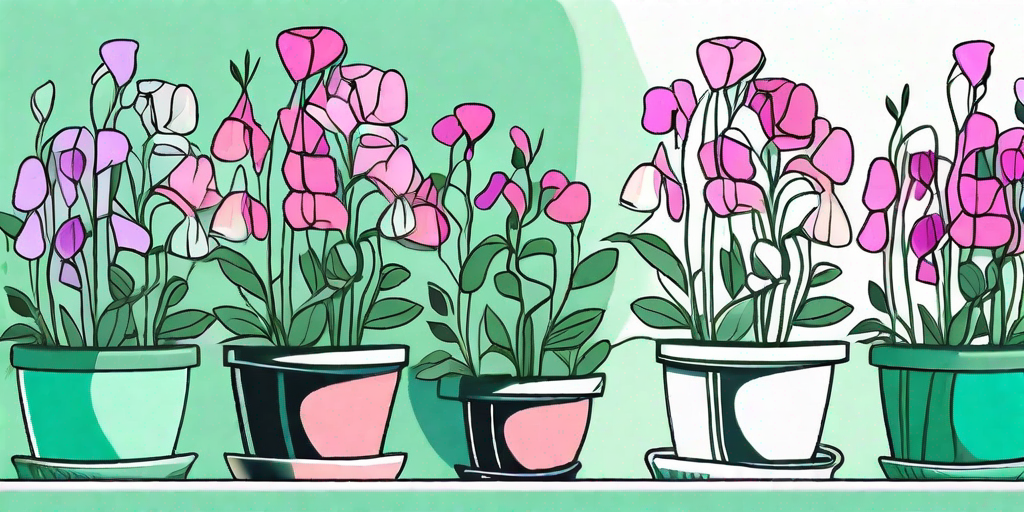
Sweet peas, with their vibrant colors and intoxicating fragrance, are a favorite among gardeners and flower enthusiasts alike. But did you know that you don't need a sprawling garden to grow these beauties? That's right, folks! You can grow sweet peas in pots, and it's easier than you might think. Let's dive into the world of container gardening and unravel the secrets of growing sweet peas successfully in pots.
Why Grow Sweet Peas in Pots?
Before we get into the nitty-gritty of how to grow sweet peas in pots, let's address the elephant in the room: why would you want to grow sweet peas in pots in the first place? Well, there are several reasons, and they're all pretty compelling.
Firstly, growing sweet peas in pots allows you to garden without a garden. Whether you live in an apartment with a small balcony or a house without a yard, container gardening is a fantastic way to bring a bit of nature into your life. Plus, it's a great conversation starter. Imagine your guests' surprise when they see your blooming sweet peas!
Secondly, growing sweet peas in pots gives you more control over the growing conditions. You can easily move the pots around to ensure they get the right amount of sunlight, and you can monitor and adjust the soil conditions more easily than in a garden bed.
Lastly, growing sweet peas in pots is just plain fun. It's a rewarding hobby that can bring a lot of joy and satisfaction. Plus, who doesn't love the sight and smell of fresh flowers?
How to Grow Sweet Peas in Pots
Choosing the Right Pot
When it comes to growing sweet peas in pots, the first step is choosing the right pot. Sweet peas have a deep root system, so you'll need a pot that's at least 12 inches deep. The width of the pot will depend on how many plants you want to grow. As a rule of thumb, plan for about 8 inches of space per plant.
The material of the pot can also make a difference. Plastic pots are lightweight and inexpensive, but they may not provide the best insulation against temperature changes. Terracotta pots, on the other hand, are heavier and more expensive, but they offer better insulation and are more durable.
Preparing the Soil
Sweet peas prefer well-drained soil with a neutral to slightly alkaline pH. You can buy potting soil from a garden center, or you can make your own by mixing equal parts of garden soil, compost, and perlite or sand. If you're using garden soil, make sure it's free of pests and diseases.
Before planting, soak the soil thoroughly and let it drain. This will ensure that the soil is moist but not waterlogged, which is important for the health of the sweet pea plants.
Planting the Seeds
Now comes the fun part: planting the seeds! Sweet peas can be sown directly into the pot, or you can start them indoors and transplant them later. If you're sowing directly, plant the seeds about 1 inch deep and 8 inches apart. Cover them with soil and water gently.
If you're starting the seeds indoors, plant them in small pots or seed trays. Once the seedlings have developed two sets of true leaves, they can be transplanted into the larger pot.
Caring for Your Sweet Peas
Once your sweet peas are planted, they'll need some TLC to thrive. Water them regularly, but be careful not to overwater. The soil should be moist, but not soggy. If the top inch of soil is dry, it's time to water.
Sweet peas also need plenty of sunlight, so place your pots in a sunny spot. If you're growing sweet peas indoors, you may need to supplement with grow lights.
Finally, sweet peas benefit from regular feeding. Use a balanced fertilizer every two weeks during the growing season to keep your plants healthy and productive.
Common Problems and Solutions
Pests and Diseases
Like all plants, sweet peas can be affected by pests and diseases. Common pests include aphids, slugs, and snails, while common diseases include powdery mildew and root rot.
To prevent pests, keep your plants healthy and monitor them regularly. If you notice any pests, remove them manually or use an organic pesticide. To prevent diseases, ensure your pots have good drainage and avoid overwatering.
Leggy Plants
If your sweet peas are growing tall and spindly with few flowers, they're probably not getting enough sunlight. Move your pots to a sunnier spot, or supplement with grow lights if you're growing indoors.
FAQs
- Can sweet peas grow in partial shade?
While sweet peas prefer full sun, they can tolerate partial shade. However, they may not flower as profusely in less sunny conditions.
- How often should I water my sweet peas?
Water your sweet peas when the top inch of soil is dry. This could be every few days in hot weather or once a week in cooler weather.
- Do sweet peas need a trellis?
Yes, sweet peas are climbing plants and will need a trellis or some other form of support to grow properly.
Conclusion
And there you have it, folks! Growing sweet peas in pots is not only possible, but it's also a fun and rewarding hobby. With the right pot, soil, and care, you too can enjoy the beauty and fragrance of sweet peas, no matter where you live. So why not give it a try? You might just find that it's a blooming success story!















